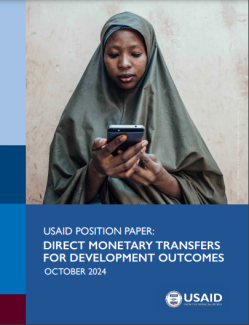Direct monetary transfers to individuals, households, or microenterprises—a form of market-based assistance—have generated significant global interest over the last twenty years. Allowing people to decide for themselves how to use development assistance respects their dignity and enables them to address their unique needs and local priorities. Despite compelling evidence that direct monetary transfers are effective to achieve a variety of development outcomes, this approach is most commonly applied within USAID as a tool for emergency humanitarian response.
This Position Paper clearly states that USAID should include direct monetary transfers as a core element of its development toolkit. Direct monetary transfers can be effective on their own, and can in some cases be made more effective through the addition of targeted “plus” elements which address other development challenges.
This paper summarizes five guiding principles for using direct monetary transfers and “transfers plus” to achieve development goals.
- Follow the evidence to achieve greater impacts, whether on short- or longer-term outcomes
- Direct monetary transfers can strengthen local markets
- Direct monetary transfers can help USAID achieve its localization ambitions and USAID's broader goal to support local systems, actors, and communities
- Design matters
- Leverage USAID’s existing authorities and experience to operationalize direct monetary transfers
Better leveraging direct monetary transfers—designed and adapted for the specific context and objectives at hand—can drive greater progress on global development challenges. Direct monetary transfers not only generate consistently and comparatively strong impacts on common development outcomes, but also further other USAID priorities. They respect the dignity of individuals by empowering them to make choices for themselves, and promote efficient markets such that entire communities and regions, not just recipients grow and benefit. In sum, direct monetary transfers provide USAID with a flexible, localized, and empowering programming approach to achieve development objectives.
To learn more about the Direct Monetary Transfers Position Paper, please contact Office of the Chief Economist at oce@usaid.gov.

